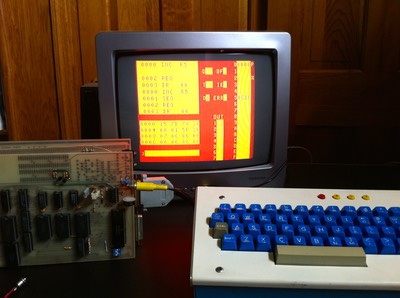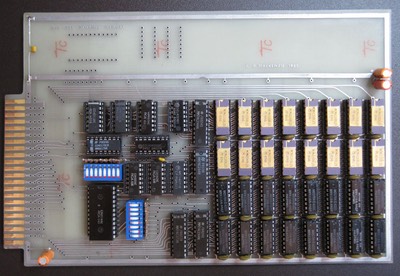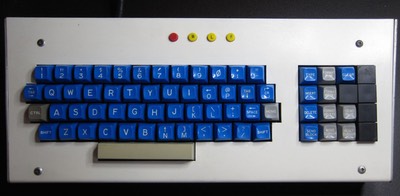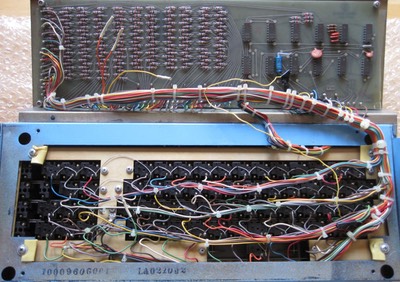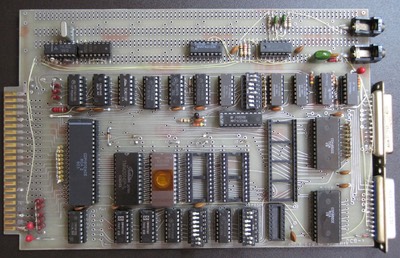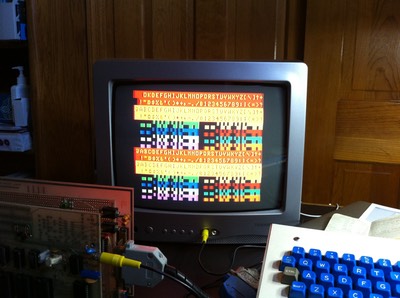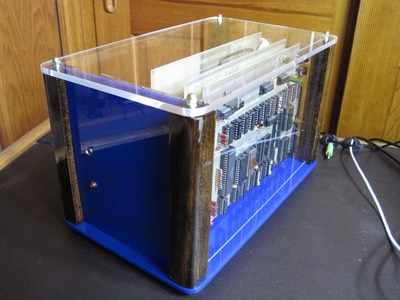My ACE computer is made up of boards produced in the early 1980s by the Association of Computer Experimenters, the Ontario based club that published the Ipso Facto newsletter for 1802 enthusiasts.
It started out as an expansion to an ELF II computer using the ELF II to ACE bus adapter board. The adapter board was announced in Ipso Facto 23, the June 1981 issue. It was designed so that the ELF II could serve as the CPU and front panel by mounting an 86 pin edge connector on the bottom side of the ELF II, and supported 2 Netronics expansion slots and 6 44 pin ACE bus slots. The layout and schematics of this board were published in Ipso Facto 25, October 1981. The Netronics Giant board moved from its original slot on top of the ELF II to one of the slots below.
A dynamic memory board was purchased at the same time as the adapter. The ACE dynamic memory card supported up to 64K using readily available 4116 (16K x 1) DRAMs, with the ability to selectively disable 4K blocks. This board was announced with schematics in Ipso Facto 28, March 1982. Initially this board was populated with 16K of RAM.
ASCII input to the system was from a Sanders 720 data entry keyboard, purchased as surplus from a company called PolyPaks. The keyboard dated back to 1968 and had no provision for lowercase characters, but provided a simple parallel output with a strobe that was easy to interface to the system.
A TVT board made up of about 50 TTL chips was purchased at a hamfest and added to the system. This board used a simple parallel input with a strobe and provided uppercase text output to a composite monitor --- a Sears 5" black and white TV/radio that had been hacked to bypass the RF demodulator.
This computer was used with figForth from the Forth Interest Group to develop an IC tester for a college project. Midway through the project the VDU board blew a chip that couldn't be obtained without a $50 minimum order. With money tight, the project was completed using the ELF II's pixie graphics at max resolution (64 pixels across by 128 down) and a TVT program I published in Ipso Facto 35, June 1983.
The next card added to the system was the ACE VDU board, based upon Motorola's MC6847. This chip provided simple 32 character by 16 line alphanumeric display as well as color graphic and semi-graphic modes. This was actually one of the first boards ACE made available. The original circuit was written up by John Myszkowski in Ipso Facto 13, September 1979. By the time I purchased this card, it went through several iterations of improvements.
After college, I decided to try making a more competitive computer out of what I had on-hand and purchased one of ACE's CPU boards, severing the last of the Netronics ELF II from the system. The ACE CPU was introduced in Ipso Facto 31, October 1982, and could function as the heart of an ACE system or as a standalone computer. Schematics were published in Ipso Facto 38, December 1983.
With student loan inspired frugality, I sawed up the ACE Netronics adapter board to use as a backplane, and butchered the Giant Board for parts.
The intent at the time was to add the ACE disk controller and some floppy drives, but by this point the writing was on the wall for ACE, Ipso Facto, and the hope of an 1802-based system holding its own against the tide of CP/M machines, Apple, and of course IBM. I moved on, buying a Xerox 820 board and building a CP/M system out of it.
Both the ACE system and the ELF II that seeded it remain almost as they were in the mid-1980s. Sentimentality kept me from harming the ELF II, and today it is in more or less its original configuration, with 256 bytes of RAM, no ROM, no I/O, and no mass storage.
The ACE system has the ACE CPU board, dynamic RAM board, and VDU board, all on the crudely hewn backplane. It clocks at 3 MHz, and has 62K RAM (counting the 512 bytes to 6K used for video) and 2K of ROM. The ROM runs a customized version of Richard Cox's monitor program from Ipso Facto 19, late 1980. The customizations support the ACE VDU and the Sanders keyboard, as well as adjusting the tape time constants for the 3 MHz clock.
New to the system after 30 years, and just in time for the exhibit at VCFMW 9.0 in 2014, a cabinet! Hopefully this will keep the dog hair out and prevent accidental electrocution.
